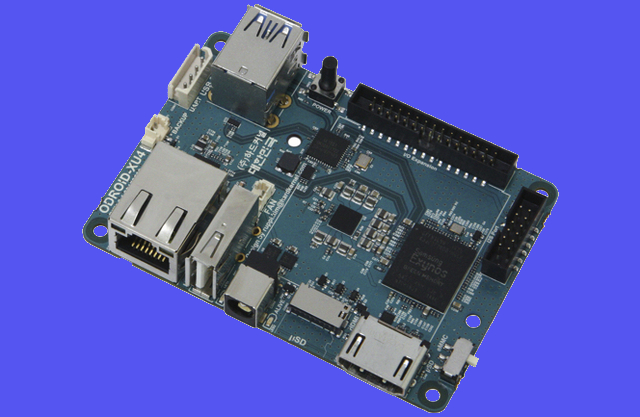
An octo-core for less than $100
The ODROID XU4 is a single board computer built by Hardkernel. At the heart of the XU4 is a Samsung Exynos 5422 2GHz, octo-core processor, with 2GB of RAM. The board also packs gigabit Ethernet, two USB 3.0 ports, a single USB 2.0 port, HDMI output, a CPU cooling fan, and general-purpose input/output (GPIO) ports for your own tinkering and experimenting. The ARM-based computer can run a number of operating systems including Debian, Ubuntu, and Android.
You’ll pay $75 for the computer, though you’ll also need to add a memory card and peripherals. A Lenovo 100S Chromebook, for comparison, starts at $180 with a dual-core Intel Celeron processor.
Of course, one big difference between a low-cost computer like a dual-core Chromebook, and the octo-core ODROID, is the computing architecture. While the Lenovo 100S has an Intel x86 chip common in most PCs, the ODROID XU4 uses the mobile ARM architecture, which is incompatible with x86 software. That means it can’t run many of the apps and operating systems you’d use with a desktop.
x86? ARM? What’s the difference?
It can get a bit complicated to explain the difference between x86 and ARM computers, but the simplest explanation is that all computers turn code into the binary 1s and 0s, and x86 and ARM computers do it in different ways. Because of that difference, an application designed and coded for an x86 processor cannot run on an ARM processor.
So how does a computer get around that limitation? It uses an emulator, which essentially serves as a code translator. While most emulators run too slowly for modern applications, a Russian developer called Eltechs has created Exagear Desktop, a piece of software that emulates x86 software, including Wine for Windows applications like Microsoft Office.
First, we’re going to see what the ODROID XU4 can handle on its own. Then we’re going to use the Exagear Desktop to handle any must-have applications that don’t work.
Getting started with Ubuntu and Exagear Desktop
We installed the ARM version of the popular Linux distribution Ubuntu on the ODROID XU4. Ubuntu has a fully featured graphical user interface, bundled office applications, and is (relatively) simple to use. Much of the open source software you can download on Ubuntu has been ported to the ARM architecture, including VLC, LibreOffice, Firefox, an open-source version of Chrome called Chromium, and countless other applications and tools.

The ODROID XU4 also supports OpenGL graphics acceleration for buttery-smooth media. That includes native support for many graphically intense applications such as GIMP, VLC, and Kodi, all of which get a boost from the built-in Mali-450 GPU.
If you’re looking for applications supported by proprietary developers, such as TeamViewer, Spotify, or Adobe Acrobat, you won’t find ARM versions of the software. That’s where Exagear Desktop comes in.
It works by running a “guest operating system” inside your existing Ubuntu installation. You’re essentially running two versions of Ubuntu simultaneously, one for ARM applications, and one for x86 applications. That means you can install x86 programs just as you would on a Ubuntu desktop computer. You can also install Wine, and then run Windows applications, just as you would on a Linux desktop computer.
There are a few caveats with Exagear Desktop. It doesn’t support graphics acceleration, so very few GPU-driven games or software will work. You’ll also have a more sluggish user experience compared to applications that run native in Ubuntu. Finally, the emulator also only supports 32-bit software right now.
What works?
We tried out a host of x86 applications including Skype, Adobe Acrobat, Microsoft Office, Spotify, and TeamViewer. Each requires its own installation process manually through the terminal, which hurts usability. Microsoft Office requires you first install Wine for Windows application compatibility, and then install Office through Wine.
Applications like Adobe Reader and Skype were sluggish at times, despite the octo-core ARM processor.
In the end, all of the software we tested ran, but we didn’t try anything complex such as Photoshop, or PC games. These applications are out of the question, just as they would be on a low-cost Linux device like a Chromebook.
Even among the applications we did try, we encountered occasional problems with installations and compatibility. Applications like Adobe Reader and Skype were sluggish at times, despite the octo-core CPU that the ODROID XU4 boasts.
But just like your desktop computer, you can still get by multitasking your browser alongside a Skype conversation while reading a PDF. The ODROID gets the job done, but at a slower pace. Even graphically-intensive applications, like TeamViewer, worked.
Since you’re running two Operating Systems on top of one another, you should expect to experience issues and errors. If you’re not tech-savvy with Linux you might have a hard time resolving those errors to get applications running. Emulation is never perfect, and compatibility can vary between applications, so expect to do some occasional tinkering to make things work. This isn’t the kind of device you can give to your grandparents and expect no problems.
The Bottom Line
For less than $100, the ODROID XU4 gives you a lot for your money. The Ubuntu operating system comes with just about all the open source software you need to survive — Web browsers, video players, word processors, and coding applications.
However, if you want to do more than just get by, and use applications like Skype, Teamviewer, and Adobe Acrobat, you’ll need Exagear Desktop. Even then you must make some compromises. Applications will work when you need them, but expect performance anywhere from decent to mediocre from the emulation process.
Using an ODROID XU4 is not for those used to Windows PCs, who need Photoshop, or do a lot of gaming. That probably means most people. The ODROID XU4 offers the biggest bang for your buck in ARM computing, but our struggles with it prove that the dream of using an ARM mini-PC to replace a desktop remains just that — a dream.


